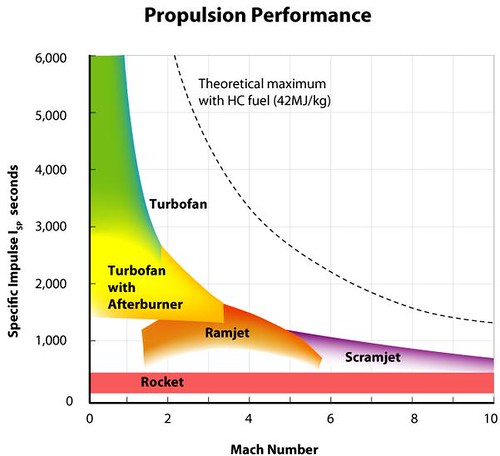NASA hypersonics expert Dr Isaiah Blankson believes that MHD energy-conversion in the intakes can take 30-40% of the energy, letting a turbine engine run at up to Mach 7. Past the MHD the air would slow from Mach 7 to Mach 3. This was the speed of the air going into engines of the Blackbird spyplanes. The Blackbird’s conventional J-58 turbojets could keep burning up to Mach 3+ because of their special intakes, which slowed the intake air down for them using a retracting central spike. This would permit the reusable first stage of a future NASA two stage to orbit launcher to take off from a runway and get its piggyback orbiter well up into scramjet-type flight regimes, all using just one set of engines.

Scramjet from Popular Science. The first true reusable, free-flying scramjet could be Darpa’s HTV-3X. It is also known as Blackswift. The HTV-3x could make its inaugural flight as early as 2012.

ISP efficiency of scramjets would be about 1000 at Mach 7.
The advantage of this proposal is that it seems like a simpler design than some other proposals for scramjets Scramjets promise to be better than rockets by not needing the 75% of the weight which is oxidizer, but designs need to simpler and not replace the oxidizer with a heavier and more expensive aircraft.
Reportedly, Blankson says extracting 30 to 40 per cent of the inflow energy would cut its speed by 50 to 75 per cent. That sounds counterintuitive, as kinetic energy is proportional to the square of velocity, but presumably a man with his background knows what he’s on about. Potentially, a Mach 7 flow would slow to Mach 3 downstream of the MHD, and then a Blackbird type setup could handle it.
Blankson has a team working on the idea at NASA’s Glenn Research Centre in Ohio, with various studies planned over the next two years. The hope is that the latest advances in high-voltage pulsed power systems might make feasible what hasn’t been to date.
One does note, of course, that there would be other uses for standstill-to-Mach-7 airframes which ran on fairly ordinary fuel and potentially had huge amounts of spare electrical power. Blankson has worked with the military before, as it happens.
If his team does well, America might get hypersonic missiles, fighters or bombers – perhaps armed with directed-energy rayguns of some kind – well before it gets a reusable space launcher.
FURTHER READING
Chemical pulse detonation engines might power scramjets and would be up to 66% more efficient than regular jet engines.
Nasa hypersonic research website is here
52 page hypersonic research proposal.
MHD generators can be 50% more efficient than conventional generators
Magnetohydrodynamics at wikipedia
The MHD ramjet/scramjet has some similarities with the Skylon concept. The MHD ramjet/scramjet could use reduced heat by slowing the air down to keep the weight of the vehicle from increasing. The Skylon concept uses the SABRE engine.
The pre-cooler is also the most aggressive and difficult part of the whole SABRE design. The mass of this heat exchanger is an order of magnitude better than has been achieved previously; however, experimental work has proved that this can be achieved. The experimental heat exchanger has achieved heat exchange of almost 1 GW/m³, believed to be a world record. Small sections of a real pre-cooler now exist.
Skylon concept: using some of the liquid hydrogen fuel to cool the air right at the inlet. The air is then burnt much like in a conventional jet. Because the air is cool at all speeds, the jet can be built of light alloys and the weight is roughly halved. Additionally, more fuel can be burnt at high speed. Beyond Mach 5.5, the air would still end up unusably hot, so the air inlet closes and the engine instead turns to burning the hydrogen with onboard liquid oxygen as in a normal rocket.
Alfin has a scramjet article which indicates that China likely has an extensive scramjet program
Popular Science discusses recent scramjet work. If it works, the HTV-3X will be the first reusable scramjet-powered plane. It will be able to take off from a runway, fly at speeds of up to Mach 6, land safely, and then do it again.

Brian Wang is a Futurist Thought Leader and a popular Science blogger with 1 million readers per month. His blog Nextbigfuture.com is ranked #1 Science News Blog. It covers many disruptive technology and trends including Space, Robotics, Artificial Intelligence, Medicine, Anti-aging Biotechnology, and Nanotechnology.
Known for identifying cutting edge technologies, he is currently a Co-Founder of a startup and fundraiser for high potential early-stage companies. He is the Head of Research for Allocations for deep technology investments and an Angel Investor at Space Angels.
A frequent speaker at corporations, he has been a TEDx speaker, a Singularity University speaker and guest at numerous interviews for radio and podcasts. He is open to public speaking and advising engagements.

Thanks for posting this, for some reason it was easier to Google than Vinge’s own pages. I just linked to the talk you linked to here: http://www.cs.bath.ac.uk/~jjb/web/ai.html